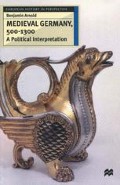Abstract
What description of the medieval German polity would be taxonomically convincing in our present state of knowledge? To find in the sources some equivalent of ‘state’ and ‘nation’ is not easy, but the labels ‘kingdom’ and ‘Empire’ are well grounded: regnum of the East Franks from the ninth century, regnum Teutonicorum from the eleventh, and Henry VII addressed as rex Alamannie by his father’s chancery in 1231.1 Romanum imperium was in literary use, as in Gerbert of Aurillac’s letters or the Vita Heinrici Quarti. It was fitfully in chancery usage in the eleventh century, and habitually in Frederick Barbarossa’s diplomas. But what sort of kingdom and Empire are being advertised in tandem? Some reverence for Frankish tradition; the immediate diplomatic geometry of the Papacy, the East Frankish kingdom, and the Lombard royal inheritance; and the capacity of Otto the Great for political innovation — all these motivated the restoration of the neo-Roman western Empire in 962.
Preview
Unable to display preview. Download preview PDF.
Notes
Mommsen and Morrison, Imperial Lives and Letters, p. 72; see now H. Hoffmann, Mönchskönig und ‘rex idiota’. Studien zur Kirchenpolitik Heinrichs II. und Konrads II., MGH Studien und Texte, vol. VIII (Hanover, 1993).
Pertinent remarks in J. B. Gillingham, The Kingdom of Germany in the High Middle Ages, 900–1200, Historical Association Pamphlets, no. LXXVII (London, 1971); Mommsen and Morrison, Imperial Lives and Letters, pp. 3–51
D. J. A. Matthew, ‘Reflections on the Medieval Roman Empire’, History, LXXVII (1992) 363–90; T. Reuter, ‘The Medieval German Sonderweg? The Empire and its Rulers in the High Middle Ages’ in Duggan, Kings and Kingship, pp. 179–211.
A. Mayhew, Rural Settlement and Farming in Germany (London, 1973) pp. 37–90; Arnold, Princes and Territories, pp. 153–67.
‘Die Pfalzen im dreizehnten Jahrhundert’ in J. Fleckenstein (ed.), Herrschaft und Stand. Untersuchungen zur Sozialgeschichte im 13. Jahrhundert, Veröffentlichungen des Max-Planck-Instituts für Geschichte vol. LI (Göttingen, 1977) pp. 277–301.
H. Aubin, ‘The Lands East of the Elbe and German Colonization Eastwards’ in M. M. Postan (ed.), The Cambridge Economic History of Europe, vol. I, The Agrarian Life of the Middle Ages, 2nd edn (Cambridge, 1966) pp. 449–86
W. Schlesinger (ed.), Die deutsche Ostsiedlung des Mittelalters als Problem der europäischen Geschichte, Vorträge und Forschungen, vol. XVIII (Sigmaringen, 1975)
F. L. Carsten, The Origins of Prussia (Oxford, 1954) pp. 1–88.
MGH Diplomata Frederick I, no. 546, pp. 3–7; F. Merzbacher, Judicium Provinciale Ducatus Franconiae. Das kaiserliche Landgericht des Herzogtums Franken-Würzburg im Spätmittelalter, Schriftenreihe zur bayerischen Landesgeschichte, vol. LIV (Munich, 1956).
G. Gudian, ‘Die grundlegenden Institutionen der Länder’, pp. 404–23, 447–9, 453–5 and A. Wolf, ‘Die Gesetzgebung der entstehenden Territorien’, pp. 586–626 in H. Coing (ed.), Handbuch der Quellen und Literatur der neueren europäischen Privatrechts Peschichte, vol. I, Mittelalter 1100–1500 (Munich, 1973).
H. Helbig and L. Weinrich (eds), Urkunden und erzählende Quellen zur deutschen Ostsiedlung im Mittelalter, vol. I, AQ vol. XXVIA (Darmstadt, 1968) no. 48, pp. 206–8; Herimanni Altahensis Annales, MGH Scriptores vol. XVII, p. 397; Annales Pegavienses et Bosovienses, MGH Scriptores vol. XVI, p. 254.
See J. Petersohn, ‘“De ortu principum Thuringie”. Eine Schrift über die Fürstenwürde der Landgrafen von Thüringen aus dem 12. Jahrhundert’, Deutsches Archiv, XLVIII (1992) 585–608.
C. J. Wells, German: A Linguistic History to 1945 (Oxford, 1985) pp. 95–125, esp. p. 109.
W. König, Atlas zur deutschen Sprache. Tafeln und Texte (Munich, 1978) pp. 56–77
W. B. Lockwood, An Informal History of the German Language, The Language Library, 2nd edn (London, 1976) pp. 11–77.
Copyright information
© 1997 Benjamin Arnold
About this chapter
Cite this chapter
Arnold, B. (1997). Conclusion: Tasks of Governance in Medieval Germany. In: Medieval Germany 500–1300. European History in Perspective. Palgrave, London. https://doi.org/10.1007/978-1-349-25677-8_5
Download citation
DOI: https://doi.org/10.1007/978-1-349-25677-8_5
Publisher Name: Palgrave, London
Print ISBN: 978-0-333-61092-3
Online ISBN: 978-1-349-25677-8
eBook Packages: Palgrave History CollectionHistory (R0)

